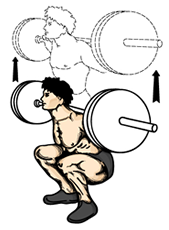User:U3034744
The Affects of Resistance Exercise on Parkinson's Disease
[edit | edit source]What's the Problem?
[edit | edit source]Parkinson's disease (PD) is a neurodegenerative condition that affects the central nervous system (CNS)[1]. An individual with PD exhibits unprogrammed cell death (necrosis) of cells responsible for producing the neurotransmitter dopamine in the brain[2]. Dopamine is involved in motor control, and patients with PD consequently have reduced functionality of certain body movements due to a lack of dopamine. Whilst there is no known cure, high intensity resistance training is one of the best treatments for PD. Resistance training limits the effects of symptoms, allowing the patient to regain a certain level of motor control[3][4].
Parkinson's Warning Signs
[edit | edit source]PD is associated with several warning signs that indicate the presence of the disease. It is important to know these sign in order to understand the health risks involved with the disease[5].
Some signs you may witness:
- Uncontrolled shaking - Loss of balance and coordination - Speech difficulties - Stiffness - Abnormal posture - Memory loss
Benefits of Resistance Exercise
[edit | edit source]Resistance training can reduce the effects of Parkinson’s disease and lower risk factors such as stumbling or falling[6].
Benefits include:
- Improved muscle strength.
- Better balance, reducing the risk of falls.
- Maintenance of posture.
- Improved walking ability.
- Improved brain functionality, leading to greater motor control
Types of Resistance Training
[edit | edit source]
There are several types of resistance training methods that can be used for Parkinson's sufferers[7].
Some resistance training options are:
- Strength/hypertrophy training.
- Plyometrics.
- Resistance band training.
- Isomteric training (force produced without movement, commonly known as tensing).
- Isokinetic training (force produced with movement at a constant speed).
Strength/hypertrophy training is highly recommended for persons with PD as its high intensity relative to other training techniques results in greater adaptations that can reduce some of the effects of the disease[8].
Exercise Example Area of improvement Leg press Quadriceps and gluteal strength/hypertrophy Leg extension Qudriceps strength/hypertrophy Hamstring curl Hamstring strength/hypertrophy Calf raises Calf strength/hypertrophy Squats Qudriceps and gluteal strength/hypertrophy Deadlifts Hamstring and gluteal strength/hypertrophy
Leg training is recommended as it is closely linked with improved movement and balance due to increased strength, hypertrophy and stabilisation of muscles[9].
For Further Information
[edit | edit source]- Daryl Smeaton: CEO Parkinson’s Australia
PO Box 717, Mawson ACT 2607, Phone: 0407 703 328
- Parkinson's Disease Foundation, Inc. 1800-457-6676
- Nationl Parkinson Foundation, Inc. Web http://www.parkinson.org/
- "Alternatively contact your local GP for additional information"
References
[edit | edit source]1. Crizzle, A. (2006). Is Physical Exercise Beneficial for Persons with Parkinson's Disease? Clinical Journal of Sports Medicine , 442-445.
2. Hirsch, M. (2003). The Effects of Balance Training and High-Intensity Resistance. Arch Phys Med Rehabil , 1109-1117.
3. Kwakkel, A. (2008). Impact of physical therapy for Parkinson's disease: A critical review of the literature. Parkinson's and Related Disorders , 478-487.
4. Leland, E. (2006). High-intensity resistance training amplifies muscle hypertrophy and functional gains in persons with Parkinson's disease. Movement Disorders , 1444-1452.
5. Michael, J. (2008). Parkinson's disease and resistive exercise: Rationale, review, and recommendations. Movement Disorders , 1-11.
6. Morris, M. (2006). Locomotor Training in People With Parkinson Disease. Physical Therapy , 1426-1435.
7. Nallegowda, M. (2002). Role of Sensory Input and Muscle Strength in Maintenance of Balance, Gait, and Posture in Parkinson's Disease: A Pilot Study. American Journal of Physical Medicine & Rehabilitation , 898-908.
8. Scandalis, T. (2001). Resistance Training and Gait Function in Patients with Parkinson's Disease. American Journal of Physical Medicine and Rehabilitation , 38-43.
9. Tamar, C. (2002). The power of cueing to circumvent dopamine deficits: A review of physical therapy treatment of gait disturbances in Parkinson's disease. Movement disorders , 1148-1160.
- ↑ Crizzle, A. (2006). Is Physical Exercise Beneficial for Persons with Parkinson's Disease? Clinical Journal of Sports Medicine , 442-445
- ↑ Hirsch, M. (2003). The Effects of Balance Training and High-Intensity Resistance. Arch Phys Med Rehabil , 1109-1117
- ↑ Hirsch, M. (2003). The Effects of Balance Training and High-Intensity Resistance. Arch Phys Med Rehabil , 1109-1117
- ↑ Kwakkel, A. (2008). Impact of physical therapy for Parkinson's disease: A critical review of the literature. Parkinson's and Related Disorders , 478-487.
- ↑ Kwakkel, A. (2008). Impact of physical therapy for Parkinson's disease: A critical review of the literature. Parkinson's and Related Disorders , 478-487.
- ↑ Michael, J. (2008). Parkinson's disease and resistive exercise: Rationale, review, and recommendations. Movement Disorders , 1-11
- ↑ Morris, M. (2006). Locomotor Training in People With Parkinson Disease. Physical Therapy , 1426-1435
- ↑ Nallegowda, M. (2002). Role of Sensory Input and Muscle Strength in Maintenance of Balance, Gait, and Posture in Parkinson's Disease: A Pilot Study. American Journal of Physical Medicine & Rehabilitation , 898-908
- ↑ Tamar, C. (2002). The power of cueing to circumvent dopamine deficits: A review of physical therapy treatment of gait disturbances in Parkinson's disease. Movement disorders , 1148-1160